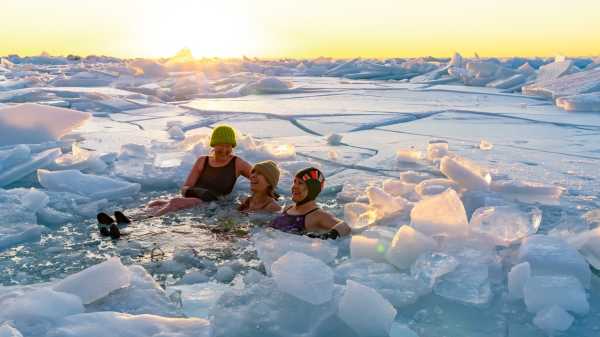
Save this storySave this storySave this storySave this story
During the depths of the pandemic, swimming gave three women a way to connect and turned them into friends.
Jennefer Hoffmann trudges in the blue pre-dawn light; the only sounds are the squeak and swish of her winter gear. “Holy shit,” she stammers, mouth open, when she reaches her destination, a lake transformed by ice. It’s Lake Michigan—but massive blue chunks evoke Antarctica. “Isn’t it beautiful?” Hoffmann’s friend, Helen Wagner, calls to her from the shore. Another friend, Deirdre Hamill-Squiers, joins them. Nearby, someone pounds away at the frozen lake with a sledgehammer, creating a hole big enough for the three women—all open-water swimmers—to bathe. “It’s raining ice,” Hoffmann says, smiling and blinking.
The trio swim every morning at sunrise—even when the water is frigid. Hoffmann got the idea after hearing about another local open-water swimmer, a woman named Joan, who swam a circle in a slurry mix of ice and water one morning. This was in the fall of 2020, and Hoffmann was in the throes of a deep depression. Immersing herself in extremely cold water allowed Hoffmann to be in the present when her mind wouldn’t stop. “Everything that is wrong or stressful just dissipates,” she says in Samantha Sanders’s documentary “Swimming Through.” She invited Wagner and Hamill-Squiers to join her. “There was no big plan,” she told me, “it was just this beautiful ‘Let’s keep going if we can.’ ”
The New Yorker Documentary
View the latest or submit your own film.

The morning ritual became “a reason to keep waking up,” Hoffmann says in the film. During the depths of the pandemic, when vaccines weren’t widely available and most people were still isolating at home, swimming gave the women a way to connect and turned them into friends. Hamill-Squiers had recently lost her husband, John, to COVID. Ecstasy and grief intermingle as the women speak frankly about what they’re going through and also shriek and laugh, giddy from the endorphins. “Swimming is this marvelous antidote,” Hamill-Squiers says in the film. “You feel superhuman,” Wagner, who’s a cancer survivor, states. She recalls going into the water after she had finished chemo and radiation. “It just felt incredible. It was this feeling of just being not broken anymore,” she says.
As the weather cooled, the women were unwilling to stop swimming or seeing one another every morning; they powered through as the leaves fell and the lake began to freeze. They took precautions: wearing waterproof gloves to protect their hands (Wagner describes breaking ice with her stroke and seeing it re-form behind her), avoiding wetsuits because they take too long to remove and the air chill can be dangerous (the coldest day they swam, the air temperature was minus twenty degrees), and getting out after only a few minutes in the water no matter how comfortable they feel (in some cases of hypothermia, you start to feel really warm). Despite the challenges, the plunges were well worth it to the women. “No matter how you’re feeling when you get in, you always feel good when you get out,” Hoffmann told me.
Sanders began photographing Lake Michigan during a polar vortex in 2015. She became fascinated by the ice formations on the surface of the water and in surrounding trees. In February, 2021, she read a Chicago Tribune article about Hoffmann, Wagner, and Hamill-Squiers. She was struck by a short clip of Hoffmann out on the ice, dressed in a two-piece and wielding a mallet. “I was just, like, ‘This is the most beautiful, amazing thing I’ve ever seen,’ ” she told me. The women’s need to swim every morning in order to cope with the isolation and stress of the pandemic resonated with her: she had been out photographing the lake at sunrise each morning in her own attempt to cope. The film captures the wild beauty of the landscape and also the emotional interiority of its subjects. Underwater footage of the swimmers creates intimacy; drone footage of the frozen lake engenders awe. But it is the quiet, matter-of-fact shots of the swimmers’ dedicated preparations that have the most power: winter accessories laid out on a bench, Hoffmann filling a thermos with hot water in the pre-dawn dark in her kitchen, the frigid walk down to the lake. Sanders’s reverence for the women, and their friendship, comes through. In one of the film’s final images, the three women clamber into a small hole in the ice and float side by side, beaming, for as long as they can bear it.
Sourse: newyorker.com







